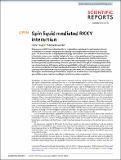Files in this item
Spin liquid mediated RKKY interaction
Item metadata
| dc.contributor.author | Legg, H. F. | |
| dc.contributor.author | Braunecker, Bernd | |
| dc.date.accessioned | 2019-11-27T12:30:11Z | |
| dc.date.available | 2019-11-27T12:30:11Z | |
| dc.date.issued | 2019-11-27 | |
| dc.identifier | 262527759 | |
| dc.identifier | b7e4353b-8cc8-4af3-977b-3a221e13d40d | |
| dc.identifier | 85075722644 | |
| dc.identifier | 000499180900001 | |
| dc.identifier.citation | Legg , H F & Braunecker , B 2019 , ' Spin liquid mediated RKKY interaction ' , Scientific Reports , vol. 9 , 17697 , pp. 1-12 . https://doi.org/10.1038/s41598-019-53842-7 | en |
| dc.identifier.issn | 2045-2322 | |
| dc.identifier.other | ArXiv: http://arxiv.org/abs/1612.06868v1 | |
| dc.identifier.other | ORCID: /0000-0002-7077-8825/work/65345422 | |
| dc.identifier.uri | https://hdl.handle.net/10023/19011 | |
| dc.description | Funding: DFG under CRC 1238 and Bonn-Cologne Graduate School of Physics and Astronomy (BCGS). | en |
| dc.description.abstract | We propose an RKKY-type interaction that is mediated by a spin liquid. If a spin liquid exists such an interaction could leave a fingerprint by ordering underlying localised moments such as nuclear spins. This interaction has a unique phenomenology that is distinct from the RKKY interaction found in fermionic systems; most notably the lack of a Fermi surface and absence of the requirement for itinerant electrons, since most spin liquids are insulators. We demonstrate that the interaction is predominately shaped by the lattice symmetries of the underlying spin liquid. As a working example we investigate the possible ordering of nuclear spins that interact through an underlying lattice of the two-dimensional spin-1/2 kagome antiferromagnet (KHAF), although the treatment remains general and can be extended to other spin liquids and dimensions. We find that several different nuclear spin orderings minimise the RKKY-type energy induced by the KHAF but are unstable due to a zero-energy flat magnon band in linear spin-wave theory. Despite this we show that a small magnetic field is able to gap out this magnon spectrum resulting in an intricate nuclear magnetism. | |
| dc.format.extent | 12 | |
| dc.format.extent | 2097527 | |
| dc.language.iso | eng | |
| dc.relation.ispartof | Scientific Reports | en |
| dc.subject | QC Physics | en |
| dc.subject | TK Electrical engineering. Electronics Nuclear engineering | en |
| dc.subject | T-NDAS | en |
| dc.subject.lcc | QC | en |
| dc.subject.lcc | TK | en |
| dc.title | Spin liquid mediated RKKY interaction | en |
| dc.type | Journal article | en |
| dc.contributor.institution | University of St Andrews. School of Physics and Astronomy | en |
| dc.contributor.institution | University of St Andrews. Condensed Matter Physics | en |
| dc.identifier.doi | https://doi.org/10.1038/s41598-019-53842-7 | |
| dc.description.status | Peer reviewed | en |
This item appears in the following Collection(s)
Items in the St Andrews Research Repository are protected by copyright, with all rights reserved, unless otherwise indicated.

